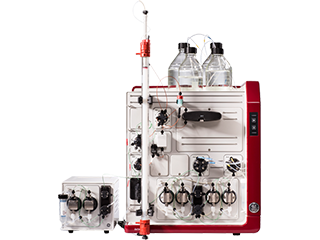
We are equipped with GE Healthcare’s ÄKTA Pure and ÄKTA Start chromatography systems, which allow for unattended operation and the efficient automation and optimization of purification tasks.
Choices of Chromatography Techniques
Commonly used chromatography techniques include: size exclusion chromatography (SEC, i.e., gel filtration), ion exchange chromatography (IEX), hydrophobic interaction chromatography (HIC), and affinity chromatography.
Affinity chromatograph is usually combined with specific affinity tags (i.e., 6xHis, GST, FLAG, etc.) that are used for the first step of purification to achieve enrichment of the target fusion protein.
Ion-exchange chromatography (IEX) step is usually chosen as a second binding/elution process of purification. Depending on the pI-values and differences between target and contaminant proteins, anion-exchange or cation-exchange matrices can be used to further purify the desired protein.
Gel filtration chromatography (SEC) is usually performed as a final polishing step and can be used to increase the purity and homogeneity of the protein sample. In brief, the proteins within a sample are separated on a porous matrix according to their size. Thus, not only can contaminant proteins with different molecular weights than that of the target protein be separated, but different oligomeric forms of the target protein can also be resolved. This polishing step can be very critical, especially for structural protein studies.
Gel filtration can also provide valuable information for the analysis of protein-protein interactions and can be informative about the association between one or more proteins or nucleic acids, under diverse conditions.
Prepacked Columns
We carry GE Healthcare’s prepacked affinity columns (i.e., HisTrap, GSTrap), desalting columns, and all sizes of SEC columns (from analytic scale Superdex increase to production grade Superdex). We also have hydrophobic interaction columns for procedures such as the removal of endotoxin and nuclease contaminants.








